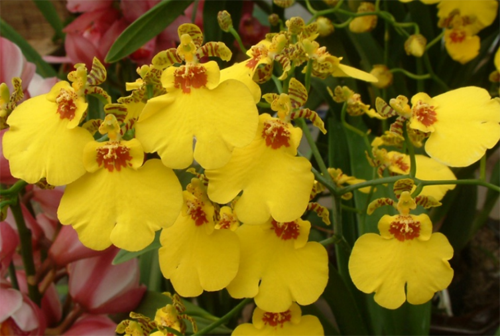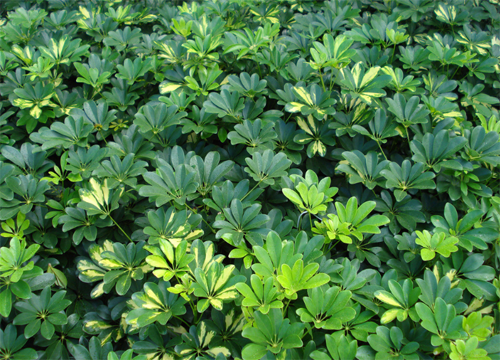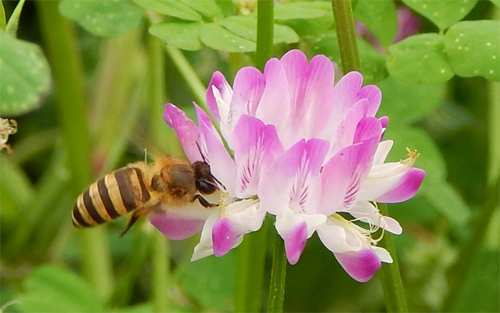What's the nickname of Oncidium's culture method?
The flowers of Oncidium are yellow flowers, which look a little like Phalaenopsis from a distance. What is the breeding method of Oncidium? What other aliases do you have?

Culture methods of Oncidium:
1, soil quality: Oncidium is suitable for growing in ventilated and drained soil, usually made of fern root, charcoal, moss, pozzolanic ash, broken bricks, bark and other materials, and can be mixed with fine fern root, peat soil, charcoal, vermiculite (perlite), broken bricks (broken stones) according to 4Rule, 1V1V1V1V1, and had better be added to the bottom of the basin by adding 1R3 broken stone (broken bricks) to facilitate drainage and ventilation.
2. Temperature: the suitable growth temperature is 12: 33 ℃, thick-leaf varieties prefer temperature, the optimum temperature is 18-25 ℃, thin-leaf varieties like cold and cool, the best temperature is 10-22 ℃. Plants stop photosynthesis below 12, the winter temperature should not be lower than 10 ℃, if the temperature exceeds 6 to 8 hours, it will die and die low, and the summer temperature exceeding 33 ℃ is also not conducive to growth. The flowering time can be increased by lowering the temperature as appropriate.
3. Sunshine: Oncidium can not accept direct sunlight except winter. It needs to cover 40-50% of the shade in summer so as not to delay growth, or even die of sunburn. The sun is relatively less strong in spring and autumn, which can cover 30% of the shade. Pay attention to the control of shading range, too much will make the plant underexposed to light, thus affecting flower bud differentiation, development and flowering.
4, moisture: like the humid environment, the growing period should not only water the basin soil early and late, but also spray water to the leaves and the ground to strengthen the moisture in the air and promote the growth of flower stems. There is no need to water at low temperatures in winter. Of course, there are great differences in the demand for water among different varieties, such as Oncidium without false bulbs, which is not tolerant to drought and is often watered as soon as it is dry.
5. Ventilation: all Oncidium need to be ventilated, especially the strains with false corms and thin leaves, which are too stuffy and prone to diseases. In the hot summer, it is not only necessary to water and spray water to the plant and the surrounding environment, but also to strengthen ventilation to facilitate cooling.
6. Fertilizer: fertilization should be carried out according to the variety and growth stage. A little slow-release fertilizer can be used for base fertilizer, and 1500-2000 times liquid water-soluble quick-acting fertilizer can be applied every 2-3 weeks, or solid fertilizer can be applied. The compound fertilizer of nitrogen, potassium and phosphorus can be applied evenly outside the flowering stage, and phosphorus and potassium fertilizer should be supplemented to facilitate flower bud differentiation and flowering when the flowering stage is approaching. When you see the flower stem or the temperature below 10 ℃, stop fertilizing, fertilize again after flowering, do not apply fertilizer in winter, and apply thin fertilizer frequently.
7. Diseases and insect pests: Oncidium generally has shell insects, snails, whitefly and other pests, especially in the rainy season, snails frequently go out and can regularly sprinkle lime powder around, shell pests can be sprayed 800 to 1000 times liquid speed to kill or fast scale Ling solution, 3000 times liquid speed aphids or aphids can kill whitefly.
The main yellow leaf disease, try to keep hygienic, pesticide spray thoroughly, leaf back, corner and ground all should be sprayed, greenhouse disinfection once a month.
The role of Oncidium:
Oncidium has a small shape, luxuriant flowers and luxuriant leaves, and its single-branch flower stem can bloom dozens to hundreds of flowers, with a strange flower shape, in the shape of a rich golden butterfly, full of dynamic beauty, long flowering period and strong appreciation. It can be used as cut flowers and potted flowers, put in bottles at home or office, and can also be used to make bouquets, baskets, etc., with its main materials, with hanging scorpion tail plantains, asparagus, wood lilies, Lingxiao and green palms as wall inserts. Full of joy and joy With swallow grass, Anthurium andraeanum, Tianmen winter, lily as a basket, can be used as a holiday gift.
The alias of Oncidium:
Oncidium, also known as Cymbidium, Dance Orchid, Cymbidium, Phalaenopsis, is a subfamily of Orchidaceae, originating from Mexico, Colombia, Peru, the United States and Guyana.
It is a general category, with more than 750 native varieties, and there are many commercial hybrids, such as leopard spot Oncidium, wrinkled Oncidium, small Golden Phalaenopsis, large flower Oncidium, wrinkled Oncidium and so on. It is a major category of cut and potted flowers.
Oncidium breeding methods and what the common name is introduced here, flower cultivation can cultivate a person's patience.
The culture method of Oncidium? Wenxin Orchid language
Oncidium, also known as auspicious orchid, dancing orchid, dancing girl orchid, golden butterfly orchid, tumor orchid and so on. Oncidium is the general name of Oncidium of Orchidaceae, with more than 750 original species, distributed in Mexico, Brazil, Jamaica and other tropical regions of Central and South America. Oncidium has a unique flower shape and has high ornamental value. Its inflorescence is well branched, beautiful in shape, bright in color, and looks like the Chinese word "Ji" at close sight, so it is also known as Jixiang Orchid.
Culture methods of Oncidium
Oncidium prefers cool climate. The optimum temperature for the growth of thick-leaf Oncidium is 18-25 ℃, and the winter temperature is not lower than 12 ℃. The suitable temperature for the growth of thin leaf type is 10: 22 ℃, and the winter temperature is not lower than 8 ℃.
Oncidium prefers humid and semi-shady environment, in addition to watering to increase substrate humidity, leaf surface and ground water spraying is more important, increasing air humidity is more beneficial to the growth of leaves and flower stems. Hard-leaf varieties have strong drought tolerance, moderate requirements for light, fear of direct light, dry death without watering for a long time in winter, and their endurance is very strong. Large-scale production requires a sunshade net, with a shading rate of 40% to 50%. Plenty of sunshine is needed in winter, usually without a sunshade net, which is beneficial to flowering. The leaves of thin-leaf species cultivated in potted plants or planting beds such as fern root, moss, volcanic ash and bark blocks are thinner and slightly leathery, and most of the whole plants grow healthily and are suitable for planting in medium-temperature greenhouse. Thick-leaf species have strong drought tolerance and will not die because of drought if they are not watered for dozens of days in winter in the greenhouse. Sword leaf species are small and suitable for family breeding.
Oncidium has many aliases, such as mascot orchid, dance orchid, dance girl orchid, golden butterfly orchid, tumor petal orchid. Most of its leaves are 1mi 3, which can be subdivided into thin leaf species, thick leaf species and sword leaf species according to the leaf thickness. Oncidium is the general name of Oncidium, it does not refer to a single plant. It has more than 750 forms, the flower shape of Oncidium is incomparable, and its ornamental value is extremely high. Now it has become a kind of flower with a wide range of commercial uses, enjoys a high reputation in the flower arrangement world, and is the representative flower of the "five beauties" of cut flowers. When it blossoms, its petals are like a Chinese character "Ji", so people call it auspicious orchid.
Wenxin Orchid language
Flower words: hidden love, silent waiting, silent yearning. Oncidium plants are light and slow, the flower stems are light and drooping, the flowers are strange and lovely, and the flowers are mainly yellow and brown, as well as green, white, red and magenta, some of which are as small as mini Oncidium, and some are very large.
Oncidium price
1, Oncidium fragrance strong indoor office table ornamental orchid chocolate dance perfume Oncidium reference price: 35.00
2, Hongyue tabletop potted orchid with perfume mini Oncidium dancing orchid seedling with bud reference price: 40.00
3, with flowers) Pocket fragrant flowers Mini Oncidium, Magnolia Magnolia, two consecutive plants reference price: 16.00
The Culture method of Oncidium how to raise Oncidium
Wenxin orchid alias dance orchid, dancing girl orchid, golden butterfly orchid, Wenxin orchid flower strange, the shape is very similar to the flying kingdee. Many novice flower friends do not know how to raise Wenxinlan? Then Xiaoqi introduced the culture method of Xiawenxin.
1. How to raise Oncidium
Oncidium's requirements for the environment are generally not too strict, but the winter temperature should not be lower than 15 ℃, and the air humidity is about 80% in the four seasons. Spring, summer and autumn need a semi-overcast environment. Sufficient sunshine can be given in winter, but do not expose it to the hot summer sun. Oncidium is often propagated by individual plants. In general, do not water immediately after dividing plants, spray some water on the leaves when a little dry, and then water when new roots grow, and then spray some average fertilizer, but the concentration is not too high, generally 0.6% to 0.8%. In the maintenance process, do not pour too much water, so it is easy to rot the root, we should pay attention to ventilation and light transmission. If there are diseased plants, they should be destroyed in time and sprayed with some fungicides. The temperature and humidity during flowering are not easy to be too high or too low, which will affect the life span of flowers, shorten the flowering period, and even appear the phenomenon of bud drop or early wilting.
2. Culture methods of Oncidium
1. Soil: because it belongs to epiphytic orchid and likes to be loose, breathable and water-retaining, it can be made of vermiculite, perlite, peat soil, charcoal, broken bricks and broken fern roots.
2. Temperature: like warmth, and the suitable temperature for growth is 18-26 ℃. Not cold-resistant, less than 12: time coordination stopped, long-term 6-8 ℃ low temperature will cause cold damage to the plant, the overwintering temperature should be kept above 13. It is also not resistant to high temperature, and its normal growth will be affected if it is higher than 33 ℃.
3. Light: like semi-overcast environment, strong light will burn the plant. It should cover 50% to 70% of the light in summer, 20% to 30% in early spring and late autumn, and no shade in winter. When the light is too strong, the plant growth is inhibited and dwarf, and sunburn occurs, and the leaves become small and yellow, and turn grayish white in severe cases. But should not be too overcast, otherwise the leaves are too long, weak and drooping, and affect the flower bud differentiation.
4. Watering: like the moist soil environment. During the growth period, there should be enough water to keep the basin soil moist, but avoid stagnant water, too wet basin soil can easily cause rotten roots. Late autumn and early winter gradually reduce watering, which is conducive to normal flowering. Watering should be controlled at low temperatures in winter, as long as the basin soil is slightly moist.
5. Humidity: prefer a higher air relative humidity, which is 60% to 80%. Too dry environment is disadvantageous to the plant growth, usually should spray water to the leaf surface and the surrounding environment. However, it should not be too wet, when the humidity is too high, the plant is prone to disease, so it should be well ventilated.
6. Fertilization: fertilizer was applied once a month during growth, nitrogen fertilizer was the main fertilizer at seedling stage, and phosphorus and potassium fertilizer was used as adult plant. The ability of root system to absorb fertilizer is poor, so fertilization should be thin, do not apply thick fertilizer, too thick fertilizer will make leaves yellow and thin, and even rotten roots wilt. Fertilization should be stopped during flowering, winter and summer.
The above is the introduction of Oncidium culture methods. Friends who like Oncidium can try to breed some of them according to the above methods.
- Prev

Culture methods and matters needing attention of duck foot wood what to do with yellow leaves
The leaves of duck foot wood are very green, it is so green all the year round, it can be said to be an evergreen tree, what are the breeding methods and matters needing attention of duck foot wood? What if there are yellow leaves in the process? Duck foot wood, also known as umbrella tree, goose palm wood. Able to withstand weak light conditions, like semi-overcast
- Next

The seed germination temperature of Chinese milk vetch
Chinese milk vetch flowers are very good-looking purple, is very lovely, sometimes in the roadside can see, is very attractive, Chinese milk vetch breeding method is what kind of it? What is the temperature suitable for seed germination? The cultivation method of Chinese milk vetch: timely sowing, Chinese milk vetch likes cool climate
Related
- Fuxing push coffee new agricultural production and marketing class: lack of small-scale processing plants
- Jujube rice field leisure farm deep ploughing Yilan for five years to create a space for organic food and play
- Nongyu Farm-A trial of organic papaya for brave women with advanced technology
- Four points for attention in the prevention and control of diseases and insect pests of edible fungi
- How to add nutrient solution to Edible Fungi
- Is there any good way to control edible fungus mites?
- Open Inoculation Technology of Edible Fungi
- Is there any clever way to use fertilizer for edible fungus in winter?
- What agents are used to kill the pathogens of edible fungi in the mushroom shed?
- Rapid drying of Edible Fungi

